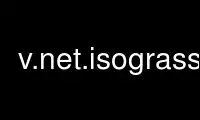
This is the command v.net.isograss that can be run in the OnWorks free hosting provider using one of our multiple free online workstations such as Ubuntu Online, Fedora Online, Windows online emulator or MAC OS online emulator
PROGRAM:
NAME
v.net.iso - Splits net by cost isolines.
Splits net to bands between cost isolines (direction from center). Center node must be
opened (costs >= 0). Costs of center node are used in calculation.
KEYWORDS
vector, network, isolines
SYNOPSIS
v.net.iso
v.net.iso --help
v.net.iso [-g] input=name output=name [arc_layer=string] [arc_type=string[,string,...]]
[node_layer=string] [arc_column=name] [arc_backward_column=name] [node_column=name]
center_cats=range costs=integer[,integer,...] [--overwrite] [--help] [--verbose]
[--quiet] [--ui]
Flags:
-g
Use geodesic calculation for longitude-latitude locations
--overwrite
Allow output files to overwrite existing files
--help
Print usage summary
--verbose
Verbose module output
--quiet
Quiet module output
--ui
Force launching GUI dialog
Parameters:
input=name [required]
Name of input vector map
Or data source for direct OGR access
output=name [required]
Name for output vector map
arc_layer=string
Arc layer
Vector features can have category values in different layers. This number determines
which layer to use. When used with direct OGR access this is the layer name.
Default: 1
arc_type=string[,string,...]
Arc type
Input feature type
Options: line, boundary
Default: line,boundary
node_layer=string
Node layer
Vector features can have category values in different layers. This number determines
which layer to use. When used with direct OGR access this is the layer name.
Default: 2
arc_column=name
Arc forward/both direction(s) cost column (number)
arc_backward_column=name
Arc backward direction cost column (number)
node_column=name
Node cost column (number)
center_cats=range [required]
Category values
Categories of centers (points on nodes) to which net will be allocated, layer for this
categories is given by nlayer option
costs=integer[,integer,...] [required]
Costs for isolines
DESCRIPTION
v.net.iso splits a network into bands between cost isolines (distance from center). Center
nodes must be opened (costs >= 0). The costs of center nodes are used in the calculation.
Costs may be either line lengths, or attributes saved in a database table. These attribute
values are taken as costs of whole segments, not as costs to traverse a length unit (e.g.
meter) of the segment. For example, if the speed limit is 100 km / h, the cost to
traverse a 10 km long road segment must be calculated as
length / speed = 10 km / (100 km/h) = 0.1 h.
Supported are cost assignments for both arcs and nodes, and also different costs for both
directions of a vector line. For areas, costs will be calculated along boundary lines.
The input vector needs to be prepared with v.net operation=connect in order to connect
points representing center nodes to the network.
NOTES
Nodes and arcs can be closed using cost = -1.
Nodes must be on the isolines.
EXAMPLES
The map must contain at least one center (point) on the vector network which can be
patched into with v.net.
Isonetwork using distance:
Isonetwork using time:
Subdivision of a network using distance:
# Spearfish
# start node:
echo "591280.5|4926396.0|1" | v.in.ascii in=- out=startnode
g.copy vect=roads,myroads
# connect point to network
v.net myroads points=startnode out=myroads_net op=connect thresh=200
# define iso networks using distance:
v.net.iso input=myroads_net output=myroads_net_iso center_cats=1-100000 costs=1000,2000,5000
The network is divided into 4 categories:
v.category myroads_net_iso option=report
# ... reports 4 categories:
#cat | distance from point in meters
#1 0 - < 1000
#2 1000 - < 2000
#3 2000 - < 5000
#4 >= 5000
To display the result, run for example:
g.region n=4928200 s=4922300 w=589200 e=596500
d.mon x0
d.vect myroads_net_iso col=blue cats=1
d.vect myroads_net_iso col=green cats=2
d.vect myroads_net_iso col=orange cats=3
d.vect myroads_net_iso col=magenta cats=4
d.vect myroads_net col=red icon=basic/triangle fcol=green size=12 layer=2
Subdivision of a network using traveling time:
Prepare the network as above:
# Spearfish
# start node:
echo "591280.5|4926396.0|1" | v.in.ascii in=- out=startnode
g.copy vect=roads,myroads
# connect point to network
v.net myroads points=startnode out=myroads_net op=connect thresh=200
Define costs as traveling time dependent on speed limits:
# set up costs
# create unique categories for each road in layer 3
v.category in=myroads_net out=myroads_net_time opt=add cat=1 layer=3 type=line
# add new table for layer 3
v.db.addtable myroads_net_time layer=3 col="cat integer,label varchar(43),length double precision,speed double precision,cost double precision,bcost double precision"
# copy road type to layer 3
v.to.db myroads_net_time layer=3 qlayer=1 opt=query qcolumn=label columns=label
# upload road length in miles
v.to.db myroads_net_time layer=3 type=line option=length col=length unit=miles
# set speed limits in miles / hour
v.db.update myroads_net_time layer=3 col=speed val="5.0"
v.db.update myroads_net_time layer=3 col=speed val="75.0" where="label=’interstate’"
v.db.update myroads_net_time layer=3 col=speed val="75.0" where="label=’primary highway, hard surface’"
v.db.update myroads_net_time layer=3 col=speed val="50.0" where="label=’secondary highway, hard surface’"
v.db.update myroads_net_time layer=3 col=speed val="25.0" where="label=’light-duty road, improved surface’"
v.db.update myroads_net_time layer=3 col=speed val="5.0" where="label=’unimproved road’"
# define traveling costs as traveling time in minutes:
# set forward costs
v.db.update myroads_net_time layer=3 col=cost val="length / speed * 60"
# set backward costs
v.db.update myroads_net_time layer=3 col=bcost val="length / speed * 60"
# define iso networks using traveling time:
v.net.iso input=myroads_net_time output=myroads_net_iso_time arc_layer=3 node_layer=2 arc_column=cost arc_backward_column=bcost center_cats=1-100000 costs=1,2,5
To display the result, run for example:
# add table with labels and coloring
v.db.addtable myroads_net_iso_time columns="cat integer,trav_time varchar(20),GRASSRGB varchar(11)"
# labels
v.db.update map=myroads_net_iso_time layer=1 column=trav_time value="0 - 1" where="cat = 1"
v.db.update map=myroads_net_iso_time layer=1 column=trav_time value="1 - 2" where="cat = 2"
v.db.update map=myroads_net_iso_time layer=1 column=trav_time value="2 - 5" where="cat = 3"
v.db.update map=myroads_net_iso_time layer=1 column=trav_time value="> 5" where="cat = 4"
# colors
# cats=1: blue
v.db.update map=myroads_net_iso_time layer=1 column=GRASSRGB value="000:000:255" where="cat = 1"
# cats=2: green
v.db.update map=myroads_net_iso_time layer=1 column=GRASSRGB value="000:255:000" where="cat = 2"
# cats=3: orange
v.db.update map=myroads_net_iso_time layer=1 column=GRASSRGB value="255:128:000" where="cat = 3"
# cats=4: magenta
v.db.update map=myroads_net_iso_time layer=1 column=GRASSRGB value="255:000:255" where="cat = 4"
# show results
g.region n=4928200 s=4922300 w=589200 e=596500
d.mon x0
d.vect myroads_net_iso_time layer=1 -a rgb_col=GRASSRGB
d.vect myroads_net col=red icon=basic/triangle fcol=green size=12 layer=2
Use v.net.isograss online using onworks.net services
